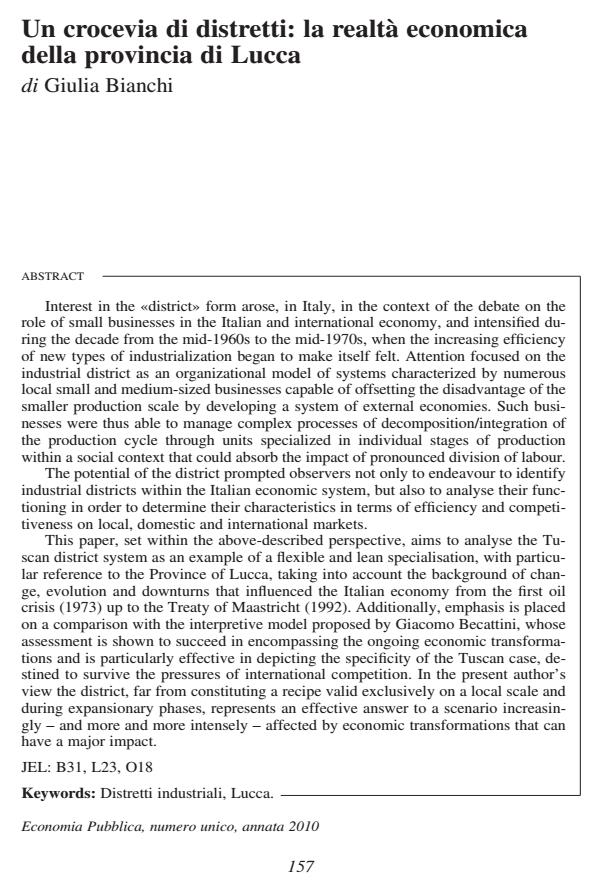Un crocevia di distretti: la realtà economica della provincia di Lucca
Titolo Rivista ECONOMIA PUBBLICA
Autori/Curatori Giulia Bianchi
Anno di pubblicazione 2012 Fascicolo 2010/1-6
Lingua Italiano Numero pagine 32 P. 157-188 Dimensione file 517 KB
DOI 10.3280/EP2010-001007
Il DOI è il codice a barre della proprietà intellettuale: per saperne di più
clicca qui
Qui sotto puoi vedere in anteprima la prima pagina di questo articolo.
Se questo articolo ti interessa, lo puoi acquistare (e scaricare in formato pdf) seguendo le facili indicazioni per acquistare il download credit. Acquista Download Credits per scaricare questo Articolo in formato PDF

FrancoAngeli è membro della Publishers International Linking Association, Inc (PILA)associazione indipendente e non profit per facilitare (attraverso i servizi tecnologici implementati da CrossRef.org) l’accesso degli studiosi ai contenuti digitali nelle pubblicazioni professionali e scientifiche
Interest in the «district» form arose, in Italy, in the context of the debate on the role of small businesses in the Italian and international economy, and intensified during the decade from the mid-1960s to the mid-1970s, when the increasing efficiency of new types of industrialization began to make itself felt. Attention focused on the industrial district as an organizational model of systems characterized by numerous local small and medium-sized businesses capable of offsetting the disadvantage of the smaller production scale by developing a system of external economies. Such businesses were thus able to manage complex processes of decomposition/integration of the production cycle through units specialized in individual stages of production within a social context that could absorb the impact of pronounced division of labour. The potential of the district prompted observers not only to endeavour to identify industrial districts within the Italian economic system, but also to analyse their functioning in order to determine their characteristics in terms of efficiency and competitiveness on local, domestic and international markets. This paper, set within the above-described perspective, aims to analyse the Tuscan district system as an example of a flexible and lean specialisation, with particular reference to the Province of Lucca, taking into account the background of change, evolution and downturns that influenced the Italian economy from the first oil crisis (1973) up to the Treaty of Maastricht (1992). Additionally, emphasis is placed on a comparison with the interpretive model proposed by Giacomo Becattini, whose assessment is shown to succeed in encompassing the ongoing economic transformations and is particularly effective in depicting the specificity of the Tuscan case, destined to survive the pressures of international competition. In the present author’s view the district, far from constituting a recipe valid exclusively on a local scale and during expansionary phases, represents an effective answer to a scenario increasingly - and more and more intensely - affected by economic transformations that can have a major impact.
Parole chiave:Distretti industriali, Lucca.
Jel codes:B31, L23, O18
Giulia Bianchi, Un crocevia di distretti: la realtà economica della provincia di Lucca in "ECONOMIA PUBBLICA " 1-6/2010, pp 157-188, DOI: 10.3280/EP2010-001007